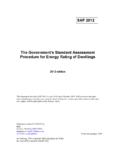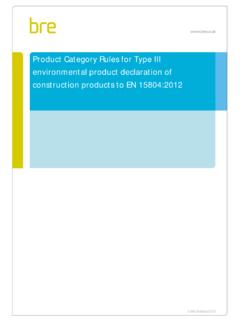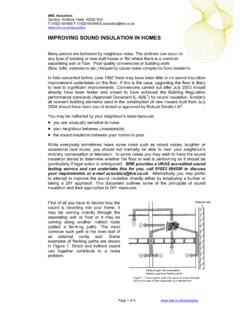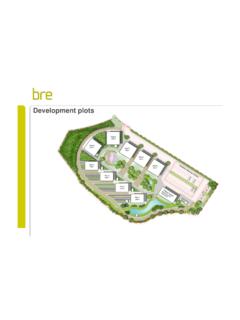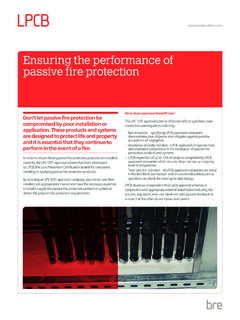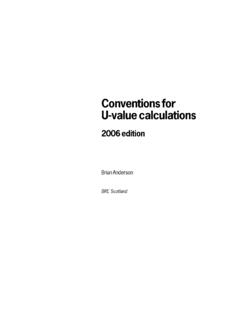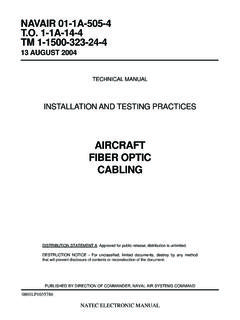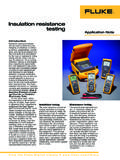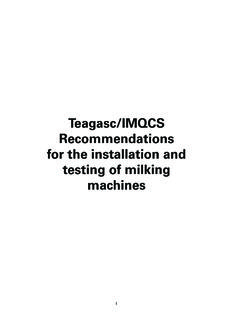Transcription of Photovoltaics in Buildings - BRE
1 Photovoltaics in BuildingsGuide to the installation of PV systems2nd Editionthe department for EnterpriseDTI/Pub URN 06/197273376 COVERS 17/10/06 3:10 pm Page 2 The work described in this report was carried out under contract as part of the DTI Sustainable EnergyProgrammes. The views and judgements expressed in this report are those of the contractor and do not nec-essarily reflect those of the DTI. This guide was originally prepared by BRE and others on behalf of the effort has been made to ensure that the information given herein is accurate but no legal responsibili-ty can be accepted by the DTI, BRE and their collaborators, for any errors, omissions or misleading statements.
2 Crown Copyright 2006 ETSU Report No:ETSU S/P2/00355/REP/1 AuthorsBREEA TechnologyHalcrow GroupSunDog Energy(2nd Edition: Sundog Energy, Halcrow Group, Energy Saving Trust)AcknowledgmentsThanks to the following for commenting on the draftsIEE, HSE, ESD, Intersolar, NAPS Systems, NHBC, Dulas,CREST, DTI Engineering Inspectorate, EST, thanks to Martin CotterellFirst Published20022nd Edition2006 Preface to 2nd edition 2006 Since the first edition (2002) the guide has been updated to reflect the significant experience gained with-in the UK PV industry under the DTI solar PV grants programmes. Other major changes covered include:lEngineering Recommendation G83/1(2003) issued to replace ER G77/1ladditional guidance for off-grid battery systemslguidance for larger systems connected under ER G59/1lPart P building Control notification Requirements73376 COVERS 17/10/06 3:10 pm Page Standards and Parallel Note on Ready reference to the List of Design part 1 PV Standard building integrated system - minimum voltage and current PV array cables.
3 1 Cable Cable type and installation String Main plug and socket Other inline cable Junction String Blocking Design part 2 earthing and lightning Earthing of exposed conductive parts (array frame) System earthing ( conductor earthing) Inverter Lightning and surge Lightning protection Surge protection Design part 3 fault current Metering2673376 GUIDE 17/10/06 3:01 pm Page 3 ContentsIntroduction5 GUIDE TO THE installation OF PV ScopeThe scope of this document is to supply system installers with information toensure that a mains-connected PV system meets current UK standards and bestpractice recommendations.
4 It is primarily aimed at small-scale installations (lessthan 16A per phase, as per the scope of ER G83/1). The scope has been extended in this 2nd edition to provide some guidance onlarger systems and off-grid battery design of the PV array is not within the scope of this document. BREdigest 489 Wind loads on roof-based photovoltaic systems , and BRE Digest 495 Mechanical installation of roof-mounted photovoltaic systems , give guidance inthis area. Standards and RegulationsAny PV system must comply with Health and Safety Requirements, BS 7671, andother relevant standards and Codes of Practice. Much of the content of this guideis drawn from such requirements.
5 While many UK standards apply in generalterms, at the time of writing there is still relatively little which specifically relates toa PV installation . However, there are two documents which specifically relate tothe installation of these systems that are of particular relevance: Engineering Recommendation G83/1 (2003) Recommendations for the connection of small scale embedded generators (up to 16A per phase) in parallel with public low voltage distribution networks IEE Guidance Note 7 to BS 7671 - Special Locations, Section 12 Solar photovoltaic (PV) Power Supply Systems (ISBN 0 85296 995 3, 2003) Safety From the outset, the designer and installer of a PV system must consider thepotential hazards carefully, and systematically devise methods to minimise therisks.
6 This will include both mitigating potential hazards present during and afterthe installation long-term safety of the system can be achieved only by ensuring that thesystem and components are correctly designed and specified from the outset,followed by correct installation , operation and maintenance of the of operation under both normal and fault conditions is essential inthe design stage to ensure the required level of safety. This aspect is covered inthe DESIGN section of this Design part 4 design DNO Planning building Regulations - part P (electrical safety) Battery PV array charge Battery overcurrent Battery Cables in battery PV String cable and fuse Battery selection and Battery System performance Inverter System PV specific circuits - Sequence of Live Shock hazard (safe working practices)
7 SYSTEM INSPECTION, TESTING & COMMISSIONING REQUIREMENTS, DOCUMENTATION & Inspection and Array commissioning G83/1 and G59/1 Operational & maintenance manual42 Appendix A G83/1 installation commissioning confirmation form43 Appendix B Electrical installation certificate45 Appendix C PV commissioning test sheets47 Further reading5173376 GUIDE 17/10/06 3:01 pm Page 47It is then important to ensure that the long-term safety of the system is notcompromised by a poor installation or subsequent poor maintenance. Much of this comes down to the quality of the installation and system inspection andtesting regime. This is covered in the installation section of this guide.
8 Similarly, much can be done during the planning and design stage to ensure thatthe installation is safe for the installers. In some circumstances the application ofthe CDM regulations will be required. (Projects that employ fewer than five peopleon site, and that last less than 30 days, or involve fewer than 500 person-days ofwork are exempt). All key safety issues affecting the design and installationprocess are discussed in the guide. The main safety issues are: The supply from PV modules cannot be switched off, so special precautionsshould be made to ensure that live parts are either not accessible or cannotbe touched during installation , use and maintenance.
9 PV modules are current-limiting devices, which require a non-standardapproach when designing fault protection systems, as fuses are not likely to blow under short-circuit conditions. PV systems include wiring, with which few electrical installers are familiar. The installation of PV systems presents a unique combination of hazards dueto risk of electric shock, falling and simultaneous manual handling of these hazards are encountered as a matter of course on a building site,but rarely all at once. While roofers may be accustomed to minimising risks offalling or injury due to manual handling problems, they may not be used todealing with the risk of electric shock.
10 Similarly, electricians would be familiarwith electric shock hazards but not with handling large objects at heights. Parallel GenerationA mains-connected PV installation generates electricity synchronised with theelectricity supply. Installers are obliged to liase with the relevant DistributionNetwork Operator (DNO) in the following manner: Single installation covered by G83/1 notification at or before day of commissioning followed by G83/1 paperwork (G83/1 appendix 3) within 30 days. Multiple installation covered by G83/1 application to proceed (G83/1 appendix 2). On commissioning notification and appendix 3 as : For single installations of slightly greater than 16A attention is drawn to Note 2 in G83/1 For the connection of small embedded generators with a rating greater than 16A per phase the DNO may choose to use this Engineering Recommendation if it is considered to be more appropriate than G59/1.

